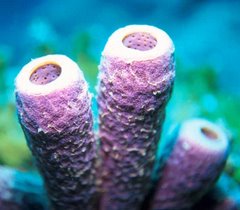
ADAPTATIONS
Poriferans are well adapted to their environments and have dense structures that aid them in harsh conditions. For instance, sponges must be able to control the high volume of water diffusing through them each day and they achieve this through constricting their pores for easy management. By monitoring the amount of water flow through their structures filter detritus particles resourcefully.
 Often sponges are able to emit a toxic substance into their environments as means of protection. These toxic substances are also useful in ensuring space for a sponge to cultivate. As marine life progresses, sponges are finding more and more competition in finding a suitable niche. However, symbiotic relationships between Poriferans and other sponges also continue to emerge. One can easily find relationships between sponges, algae, and bacteria in which sponges supply protection as the symbiont provides food. The toxins released by the sponge (as mentioned earlier) can also provide a solid shield of defense for the organisms within the symbiotic relationship.
Often sponges are able to emit a toxic substance into their environments as means of protection. These toxic substances are also useful in ensuring space for a sponge to cultivate. As marine life progresses, sponges are finding more and more competition in finding a suitable niche. However, symbiotic relationships between Poriferans and other sponges also continue to emerge. One can easily find relationships between sponges, algae, and bacteria in which sponges supply protection as the symbiont provides food. The toxins released by the sponge (as mentioned earlier) can also provide a solid shield of defense for the organisms within the symbiotic relationship.RESPONSE
Sea sponges do not have senses and cannot taste, see, hear, smell or feel (touch), and because sea sponges do not have nerves, they cannot actively respond to their surrounding environment. To protect themselves from predators, sea sponges rely on their spicules. The sharp, needle-like spicules work to make digestion hard and uncomfortable for their attackers.


No comments:
Post a Comment